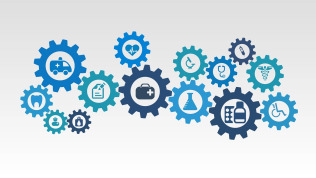 Recent trends in the business literature show a significant focus on the mechanics of the culture of organizations. Annual training reinforcing the quality and compliance requirements of organizations is a common end-of-year task. To provide some context for the training, it is important to look at the synergy between the cultures of compliance and quality, and how that synergy supports customer satisfaction. Continue reading
Recent trends in the business literature show a significant focus on the mechanics of the culture of organizations. Annual training reinforcing the quality and compliance requirements of organizations is a common end-of-year task. To provide some context for the training, it is important to look at the synergy between the cultures of compliance and quality, and how that synergy supports customer satisfaction. Continue reading
Tag Archives: mobility
Engaging Your Consumer: The New Wave of Healthcare Business
One of the major transformations in healthcare today centers on the development of the patient as a consumer. Patients are driving a demand for increased connectivity with their providers, and have a growing expectation for convenient and customizable care.
patient as a consumer. Patients are driving a demand for increased connectivity with their providers, and have a growing expectation for convenient and customizable care.
As the consumerization of healthcare continues to evolve, the patient will play a larger role in overall healthcare IT strategy. As a result, health IT vendors will need to address changing consumer demands in an age of instant gratification and convenience. What are the driving forces behind this shift?
Part Two: Our 2018 Health IT Wish List
 The healthcare IT industry enters 2018 with a lot of potential, along with the need to overcome structures that have historically stunted progress. What is on our health IT wish list? AirStrip is feeling optimistic about the industry’s direction in terms of broader collaboration for building up truly interoperable systems to improve patient care, and overall health system stability.
The healthcare IT industry enters 2018 with a lot of potential, along with the need to overcome structures that have historically stunted progress. What is on our health IT wish list? AirStrip is feeling optimistic about the industry’s direction in terms of broader collaboration for building up truly interoperable systems to improve patient care, and overall health system stability.
Part One: A Look Back on Health IT in 2017
 2017 was a roller-coaster ride for healthcare, marked by exciting innovation, damaging cyberattacks, periods of lulls and disruptive change. As we enter a new year, it is important to celebrate the industry’s successes in 2017, and reflect on the ways these changes, incidents, and regulations both pushed health IT forward and established a foundation for 2018. From the consumerization of healthcare, to the implications of a changing reimbursement structure, to increases in health IT M&A, here is what three AirStrip executives and consultants identified as the most impactful change in health IT last year:
2017 was a roller-coaster ride for healthcare, marked by exciting innovation, damaging cyberattacks, periods of lulls and disruptive change. As we enter a new year, it is important to celebrate the industry’s successes in 2017, and reflect on the ways these changes, incidents, and regulations both pushed health IT forward and established a foundation for 2018. From the consumerization of healthcare, to the implications of a changing reimbursement structure, to increases in health IT M&A, here is what three AirStrip executives and consultants identified as the most impactful change in health IT last year:
2018: Shifting Healthcare’s Mindset to the Mobile Patient
 This past year, 2017, has been a challenging year for many industries, and healthcare is certainly no exception. Not only are there major challenges connected to an increasingly aging population and outdated healthcare infrastructure, but the industry is also adapting to the policies associated with a new presidential administration. While technology will continue to be a key part of the future of healthcare, one of the biggest changes will be a shift in mindset from mobile technology to mobile patients.
This past year, 2017, has been a challenging year for many industries, and healthcare is certainly no exception. Not only are there major challenges connected to an increasingly aging population and outdated healthcare infrastructure, but the industry is also adapting to the policies associated with a new presidential administration. While technology will continue to be a key part of the future of healthcare, one of the biggest changes will be a shift in mindset from mobile technology to mobile patients.
Reflecting on IT’s Transformation of Healthcare
 As we celebrate National Health IT Week, it is incredible to realize how health technology tools are transforming every facet of patient care. From telehealth, to 3D printers to artificial intelligence, the explosion of personalized health devices redefines the dynamics of patient treatment and interactions.
As we celebrate National Health IT Week, it is incredible to realize how health technology tools are transforming every facet of patient care. From telehealth, to 3D printers to artificial intelligence, the explosion of personalized health devices redefines the dynamics of patient treatment and interactions.
However, we still fall short in comparison to other industries, particularly in terms of consistent patient information access, and the lack of incentive for industry collaboration to achieve smooth, interoperable data transfers. This week, we strike a balance between applauding our progress, yet refusing to rest on our laurels.
Back to Basics: Re-Thinking Mobility & Workflow Efficiencies Within the Hospital
 Care delivery best practices are constantly changing to optimize efficiency and safety, and look considerably different compared to just a decade ago. The digital healthcare transformation has ushered in promising opportunities to use technology to improve nurse and clinician workflows, monitor patients remotely, and provide secure paths for communication between care team members.
Care delivery best practices are constantly changing to optimize efficiency and safety, and look considerably different compared to just a decade ago. The digital healthcare transformation has ushered in promising opportunities to use technology to improve nurse and clinician workflows, monitor patients remotely, and provide secure paths for communication between care team members.
Surfing the Wave of Healthcare Change
 Healthcare is constantly evolving, and healthcare IT in particular is undergoing more change now than at any other point in history. Health systems trying to ‘ride the wave’ of change may often feel like they are implementing updates, only to face a new regulation, technology, or best suggested practice that shakes up the process yet again. While it is challenging to stay current, health systems looking to stay relevant need to constantly re-evaluate their processes and whether they are as efficient as possible. While these organizations can’t always predict what comes next, the triple aim of reducing costs, improving outcomes, and enhancing patient satisfaction, provides a solid framework for thinking ahead.
Healthcare is constantly evolving, and healthcare IT in particular is undergoing more change now than at any other point in history. Health systems trying to ‘ride the wave’ of change may often feel like they are implementing updates, only to face a new regulation, technology, or best suggested practice that shakes up the process yet again. While it is challenging to stay current, health systems looking to stay relevant need to constantly re-evaluate their processes and whether they are as efficient as possible. While these organizations can’t always predict what comes next, the triple aim of reducing costs, improving outcomes, and enhancing patient satisfaction, provides a solid framework for thinking ahead.
So how do you know where you are on the healthcare wave?
How to Innovate without Losing Control
 As the chief innovation officer of Carle Foundation Hospital, my primary responsibility is to find the best cutting-edge technology to help alleviate our physicians’ biggest pain points. This can seem like a daunting task considering the sheer quantity of technologies being produced by innovative vendors to improve the healthcare industry. I often get asked to define the ‘magic’ behind making the right decision. Ultimately, you simply have to start somewhere. With the trust of leadership and the direct involvement of our system’s physicians, I’ve determined my own process to cut through the noise and find success.
As the chief innovation officer of Carle Foundation Hospital, my primary responsibility is to find the best cutting-edge technology to help alleviate our physicians’ biggest pain points. This can seem like a daunting task considering the sheer quantity of technologies being produced by innovative vendors to improve the healthcare industry. I often get asked to define the ‘magic’ behind making the right decision. Ultimately, you simply have to start somewhere. With the trust of leadership and the direct involvement of our system’s physicians, I’ve determined my own process to cut through the noise and find success.
Telehealth: The Key to Improving Physician Workflow and Patient Care
 Several different ‘flavors’ of telehealth have developed over the years, with varying degrees of popularity and adoption. Some hospitals have telehealth systems in an emergency room, allowing ER physicians to communicate directly with physicians at another site. Other hospitals have specialty physicians who leverage telehealth visits from one health facility to another.
Several different ‘flavors’ of telehealth have developed over the years, with varying degrees of popularity and adoption. Some hospitals have telehealth systems in an emergency room, allowing ER physicians to communicate directly with physicians at another site. Other hospitals have specialty physicians who leverage telehealth visits from one health facility to another.
Telehealth equipment is generally known to be costly and limited. Traditionally, telehealth tools were permanently located in one room and only accessible when that room was available – very similar to the advent of teleconferencing rooms in offices. Unless a mobile cart was available to move from room to room, the telehealth offerings remained limited.
